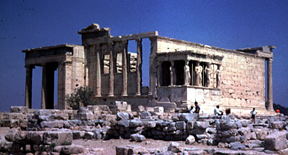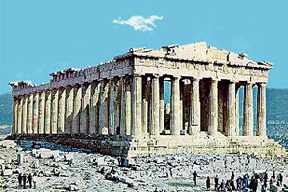|

An exploration of how and why places become invested with SACREDNESS and how the SACRED is embodied or made manifest through ART and ARCHITECTURE
THE ATHENIAN ACROPOLIS, GREECE
The Acropolis (from
the Greek acros, meaning high or upper and polis, meaning
''city) of Athens is a steep-sided hill supporting several temples, precincts, and other
buildings. Archaeological evidence indicates it has been used since Neolithic times and that even then, as the numerous female figurines found there suggest, it was associated with female power. Although it had evidently used also as a defensible place of refuge since the Bronze Age, it appears nonetheless to have been a sacred site at all times.
During the Classical period of the 5th century BCE in Athens, following the destructions of earlier temples by the Persians, the Greek general and statesman, Pericles (c. 500-429 BCE), initiated a vast rebuilding campagin for the Acropolis. The Propylaea (gateway) and the Parthenon were completed during his lifetime, but work on the Temple of Athena Nike and the Erechtheum was not begun until after his death.

A reconstruction of the Acropolis as it appeared in the 5th century BCE The principal temple on the Acropolis is the Parthenon, designed by the architects Iktinus and Kallikrates. Completed in 438 BCE as a temple dedicated to Athena, the patron goddess of Athens, the Parthenon celebrates her in her aspect as a virgin goddess. Parthenos, Greek term for virgin and the root of the word parthenogenesis (virgin birth), was one of Athena's epithets.
 Erechtheum (421-405 BCE) The Erechtheum is on the northern side of the Acropolis, opposite the Parthenon. This complex Ionic building is built on an uneven site. The eastern room was dedicated to Athena in her aspect as patron of the city. The building was called the Erechtheum by Pausanias, but this was not its official name. There were two building phases. It is a strange shape, having 4 sets of columnar supports, 4 levels, and 3 structural units, each with own roof. The reason for complexity lies in the configuration of rock surface and the previous terracing in the area, and in the obvious necessity of building around the various cult spots which make this one of the most sacred places on the Acropolis. The area contained many signs and remains of Athens' mythical past (salt-water well, trident marks). The interior was thoroughly destroyed in later times and it is now very uncertain how it was originally organized. It once contained a much venerated image wooden statue of Athena Polias. The temple also housed various other Attic deities, including Erechtheus. Bibliography:
|
|









